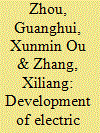|
|
|
Sort Order |
|
|
|
Items / Page
|
|
|
|
|
|
|
| Srl | Item |
| 1 |
ID:
121264


|
|
|
|
|
| Publication |
2013.
|
| Summary/Abstract |
Policies formulated to reduce greenhouse gas (GHG) emissions, such as a low-carbon fuel standard, frequently rely on life-cycle assessment (LCA) to estimate emissions, but LCA results are often highly uncertain. This study develops life-cycle models that quantitatively and qualitatively describe the uncertainty and variability in GHG emissions for both fossil fuels and ethanol and examines mechanisms to reduce those uncertainties in the policy process. Uncertainty regarding emissions from gasoline is non-negligible, with an estimated 90% confidence interval ranging from 84 to 100 g CO2e/MJ. Emissions from biofuels have greater uncertainty. The widths of the 90% confidence intervals for corn and switchgrass ethanol are estimated to be on the order of 100 g CO2e/MJ, and removing emissions from indirect land use change still leaves significant remaining uncertainty. Though an opt-in policy mechanism can reduce some uncertainty by incentivizing producers to self-report fuel production parameters, some important parameters, such as land use change emissions and nitrogen volatilization, cannot be accurately measured and self-reported. Low-carbon fuel policies should explicitly acknowledge, quantify, and incorporate uncertainty in life cycle emissions in order to more effectively achieve emissions reductions. Two complementary ways to incorporate this uncertainty in low carbon fuel policy design are presented.
|
|
|
|
|
|
|
|
|
|
|
|
|
|
|
|
| 2 |
ID:
093516


|
|
|
|
|
| Publication |
2010.
|
| Summary/Abstract |
The Chinese government has enacted policies to promote alternative vehicle fuels (AVFs) and alternative fuel vehicles (AFVs), including city bus fleets. The life cycle (LC), energy savings (ES) and GHG reduction (GR) profiles of AVFs/AFVs are critical to those policy decisions. The well-to-wheels module of the Tsinghua-CA3EM model is employed to investigate actual performance data. Compared with conventional buses, AFVs offer differences in performance in terms of both ES and GR. Only half of the AFVs analyzed demonstrate dual benefits. However, all non-oil/gas pathways can substitute oil/gas with coal. Current policies seek to promote technology improvements and market creation initiatives within the guiding framework of national-level diversification and district-level uniformity. Combined with their actual LC behavior and in keeping with near- and long-term strategies, integrated policies should seek to (1) apply hybrid electric technology to diesel buses; (2) encourage NG/LPG buses in gas-abundant cities; (3) promote commercialize electric buses or plug-in capable vehicles through battery technology innovation; (4) support fuel cell buses and hydrogen technology R&D for future potential applications; and (5) conduct further research on boosting vehicle fuel efficiency, applying low-carbon transportation technologies, and addressing all resultant implications of coal-based transportation solutions to human health and natural resources.
|
|
|
|
|
|
|
|
|
|
|
|
|
|
|
|
| 3 |
ID:
125475


|
|
|
|
|
| Publication |
2013.
|
| Summary/Abstract |
China has promoted the use of electric vehicles vigorously since 2009; the program is still in its pilot phase. This study investigates the development of electric vehicle use in China from the perspectives of energy consumption and greenhouse-gas (GHG) emissions. Energy consumption and GHG emissions of plug-in hybrid electric vehicles (PHEVs) and pure battery electric vehicles (BEVs) are examined on the level of the regional power grid in 2009 through comparison with the energy consumption and GHG emissions of conventional gasoline internal combustion engine vehicles. The life-cycle analysis module in Tsinghua-LCAM, which is based on the GREET platform, is adopted and adapted to the life-cycle analysis of automotive energy pathways in China. Moreover, medium term (2015) and long term (2020) energy consumption and greenhouse-gas emissions of PHEVs and BEVs are projected, in accordance with the expected development target in the Energy Efficient and Alternative Energy Vehicles Industry Development Plan (2012-2020) for China. Finally, policy recommendations are provided for the proper development of electric vehicle use in China.
|
|
|
|
|
|
|
|
|
|
|
|
|
|
|
|
| 4 |
ID:
098213


|
|
|
|
|
| Publication |
2010.
|
| Summary/Abstract |
This paper describes the methodology and data used to determine greenhouse gas (GHG) emissions attributable to ten cities or city-regions: Los Angeles County, Denver City and County, Greater Toronto, New York City, Greater London, Geneva Canton, Greater Prague, Barcelona, Cape Town and Bangkok. Equations for determining emissions are developed for contributions from: electricity; heating and industrial fuels; ground transportation fuels; air and marine fuels; industrial processes; and waste. Gasoline consumption is estimated using three approaches: from local fuel sales; by scaling from regional fuel sales; and from counts of vehicle kilometres travelled. A simplified version of an intergovernmental panel on climate change (IPCC) method for estimating the GHG emissions from landfill waste is applied. Three measures of overall emissions are suggested: (i) actual emissions within the boundary of the city; (ii) single process emissions (from a life-cycle perspective) associated with the city's metabolism; and (iii) life-cycle emissions associated with the city's metabolism. The results and analysis of the study will be published in a second paper.
|
|
|
|
|
|
|
|
|
|
|
|
|
|
|
|
| 5 |
ID:
098545


|
|
|
|
|
| Publication |
2010.
|
| Summary/Abstract |
This paper describes the methodology and data used to determine greenhouse gas (GHG) emissions attributable to ten cities or city-regions: Los Angeles County, Denver City and County, Greater Toronto, New York City, Greater London, Geneva Canton, Greater Prague, Barcelona, Cape Town and Bangkok. Equations for determining emissions are developed for contributions from: electricity; heating and industrial fuels; ground transportation fuels; air and marine fuels; industrial processes; and waste. Gasoline consumption is estimated using three approaches: from local fuel sales; by scaling from regional fuel sales; and from counts of vehicle kilometres travelled. A simplified version of an intergovernmental panel on climate change (IPCC) method for estimating the GHG emissions from landfill waste is applied. Three measures of overall emissions are suggested: (i) actual emissions within the boundary of the city; (ii) single process emissions (from a life-cycle perspective) associated with the city's metabolism; and (iii) life-cycle emissions associated with the city's metabolism. The results and analysis of the study will be published in a second paper.
|
|
|
|
|
|
|
|
|
|
|
|
|
|
|
|
| 6 |
ID:
109602


|
|
|
|
|
| Publication |
2011.
|
| Summary/Abstract |
Products other than biofuels are produced in biofuel plants. For example, corn ethanol plants produce distillers' grains and solubles. Soybean crushing plants produce soy meal and soy oil, which is used for biodiesel production. Electricity is generated in sugarcane ethanol plants both for internal consumption and export to the electric grid. Future cellulosic ethanol plants could be designed to co-produce electricity with ethanol. It is important to take co-products into account in the life-cycle analysis of biofuels and several methods are available to do so. Although the International Standard Organization's ISO 14040 advocates the system boundary expansion method (also known as the "displacement method" or the "substitution method") for life-cycle analyses, application of the method has been limited because of the difficulty in identifying and quantifying potential products to be displaced by biofuel co-products. As a result, some LCA studies and policy-making processes have considered alternative methods. In this paper, we examine the available methods to deal with biofuel co-products, explore the strengths and weaknesses of each method, and present biofuel LCA results with different co-product methods within the U.S. context.
|
|
|
|
|
|
|
|
|
|
|
|
|
|
|
|
|
|
|
|
|